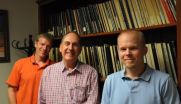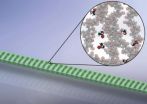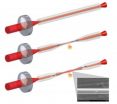(Press-News.org) DURHAM, N.C. -- Researchers at Duke Medicine have identified a new strategy for treating neuroblastoma using a modified version of heparin, a century-old injectable drug that thins the blood to prevent clots from forming.
The study, conducted in mice and published June 17, 2014, in the Journal of Clinical Investigation, found that when heparin is altered to remove its blood-thinning properties, it can suppress and shrink neuroblastoma tumors without causing severe bleeding.
"Our research translates mechanistic insights about heparin into a potential new therapy for neuroblastoma, and possibly other cancers," said senior author Gerard C. Blobe, M.D., Ph.D., professor of medicine, pharmacology and cancer biology at Duke.
Neuroblastoma is a cancer that arises in nerve tissue, and is typically seen in infants and children. While neuroblastoma is rare overall – 700 new cases in the United States each year, according to the American Cancer Society – it is the most common cancer in infants.
Despite numerous treatment options for neuroblastoma, survival rates in children with advanced cancer are less than 40 percent due to disease recurrence and the persistence of residual cancerous cells after chemotherapy. However, one difference between neuroblastoma and other solid tumors is the function of the stroma, or connective tissue around the tumor.
"Most of the time we think of stroma in solid tumors as a bad thing that helps cancers become more invasive. In neuroblastoma, it's the opposite: having a lot of connective tissue around the tumor does something favorable for patients," Blobe said.
Studying the stroma's biology, the researchers determined that the connective tissue produces and releases receptors involved in nervous system signaling called heparan sulfate proteoglycans. The heparan sulfate proteoglycans had a differentiating effect on the cancer cells, making immature cancer cells act more like mature neurons and keeping them from proliferating.
Heparan sulfate proteoglycans are structurally similar to the anticoagulant heparin, which led the researchers to hypothesize that heparin might recreate the function naturally occurring in the stroma. They administered heparin to human neuroblastoma cells in laboratory cultures as well as to mice with neuroblastoma, and found that it could differentiate cancer cells and cause tumors to regress in mice. However, the heparin caused severe bleeding, rendering it an unusable treatment.
"That's what caused the 'eureka' moment. Heparin was effective, but caused serious bleeding," said Erik H. Knelson, an M.D./Ph.D. candidate at Duke University School of Medicine and the study's lead author. "If we could find a modified heparin that still promoted differentiation but did not cause anticoagulation, we might have a successful treatment."
The researchers studied the structure of heparin, and determined that although certain properties were necessary for anticoagulation, only some were important for the signaling that promoted differentiation. Using this finding, they identified a derivative of heparin that would still allow for differentiation but not cause anticoagulation.
When tested in lab cultures, the heparin derivative suppressed neuroblastoma growth. In mice, it slowed the cancer's progression, shrunk the tumors and extended the animals' lives.
"The study illustrates the benefit of listening to the cancer and its biology," Knelson said. "We started out with an investigation of tumor stroma and its mechanism, and designed a potential therapy using this new understanding."
The team is now working to move the research into clinical trials in humans to determine whether the heparin derivative offers the same benefit in humans as it did in mice.
"We want to repurpose a drug that's already out there for the benefit of patients," Blobe said. "What's exciting about that is there are other tumors in which differentiation is useful, so there's the potential to apply these insights to other cancers."
INFORMATION:
In addition to Blobe and Knelson, study authors include Angela L. Gaviglio of the Department of Pharmacology and Cancer Biology at Duke; Jasmine C. Nee, Mark D. Starr and Andrew B. Nixon of the Department of Medicine at Duke; and Stephen G. Marcus of Cantex Pharmaceuticals.
The study was supported by the National Institutes of Health (F30 CA168043-01, R01-CA136786 and R01-CA135006) as well as a Reach Award from Alex's Lemonade Stand.
Knelson and Blobe have submitted a U.S. provisional patent application describing the development of heparin derivatives as therapeutic agents in neuroblastoma.
Heparin derivative suppresses neuroblastoma tumor growth
2014-06-17
ELSE PRESS RELEASES FROM THIS DATE:
Urban Water Management Workshop stresses more collaboration and innovation
2014-06-17
RIVERSIDE, Calif. — Where sustainability of water management is concerned, we must pay more attention to long-term solutions. Efficient water management and policy ought to be promoted at the local level. And a "portfolio approach" to water management is encouraged, one that includes information campaigns, different types of pricing, supply and reuse options, and technology-based rebate programs.
These are some of the key messages that emerged from the first Urban Water Management Workshop that took place earlier this month at the University of California, Riverside.
Sponsored ...
Swell new sensors
2014-06-17
WASHINGTON D.C., June 17, 2014 – Using microscopic polymer light resonators that expand in the presence of specific gases, researchers at MIT's Quantum Photonics Laboratory have developed new optical sensors with predicted detection levels in the parts-per-billion range. Optical sensors are ideal for detecting trace gas concentrations due to their high signal-to-noise ratio, compact, lightweight nature, and immunity to electromagnetic interference.
Although other optical gas sensors had been developed before, the MIT team conceived an extremely sensitive, compact way ...
Ultra-thin wires for quantum computing
2014-06-17
WASHINGTON D.C., June 17, 2014 - Take a fine strand of silica fiber, attach it at each end to a slow-turning motor, gently torture it over an unflickering flame until it just about reaches its melting point and then pull it apart. The middle will thin out like a piece of taffy until it is less than half a micron across -- about 200 times thinner than a human hair.
That, according to researchers at the Joint Quantum Institute at the University of Maryland, is how you fabricate ultrahigh transmission optical nanofibers, a potential component for future quantum information ...
Study reveals conditions linked to deadly bird flu and maps areas at risks
2014-06-17
BEIJING, CHINA (17 June 2014)—A dangerous strain of avian influenza, H7N9, that's causing severe illness and deaths in China may be inhabiting a small fraction of its potential range and appears at risk of spreading to other suitable areas of India, Bangladesh, Vietnam, Indonesia and the Philippines, according to a new study published today in the journal Nature Communications.
Researchers from the Université Libre de Bruxelles (ULB), the International Livestock Research Institute (ILRI), Oxford University, and the Chinese Center of Disease Control and Prevention analyzed ...
Potential cholesterol lowering drug has breast cancer fighting capabilities
2014-06-17
COLUMBIA, Mo. – Researchers at the University of Missouri have proven that a compound initially developed as a cholesterol-fighting molecule not only halts the progression of breast cancer, but also can kill the cancerous cells.
"Cholesterol is a molecule found in all animal cells and serves as a structural component of cell membranes," said Salman Hyder, the Zalk Endowed Professor in Tumor Angiogenesis and professor of biomedical sciences in the College of Veterinary Medicine and the Dalton Cardiovascular Research Center at MU. "Because tumor cells grow rapidly they ...
Bats make social alliances that affect roosting behavior
2014-06-17
Depending on habitat availability, the endangered Indiana bat may be able to use its social connections to survive a certain amount of roost destruction, according to research by scientists at Virginia Tech and The Ohio State University.
Alexander Silvis of Lynchburg, Ohio, and Andrew Kniowski of Boones Mill, Virginia, both doctoral students in Virginia Tech's College of Natural Resources and Environment, made findings from Ohio State field studies highly visual by applying graphic and spatial approaches to the data.
"Social dynamics are important to bat roosting behavior," ...
Researchers map genomic differences in yellow fever, malaria mosquitoes
2014-06-17
Virginia Tech entomologists have developed a chromosome map for about half of the genome of the mosquito Aedes agypti, the major carrier of dengue fever and yellow fever.
With the map, researchers can compare the chromosome organization and evolution between this mosquito and the major carrier of malaria, the Anopheles gambiae mosquito, to find ways to prevent diseases.
"Despite looking somewhat similar, these mosquitoes diverged from each other about 150 million years ago. So, they are genetically further apart than humans and elephants," said Maria Sharakhova, a ...
Study reveals livestock gut microbes contributing to greenhouse gas emissions
2014-06-17
"Increased to levels unprecedented" is how the Intergovernmental Panel on Climate Change (IPCC) described the rise of carbon dioxide, methane and nitrous oxide emissions in their report on the physical science basis of climate change in 2013. According to the US Environmental Protection Agency (EPA), the atmospheric concentration of methane, a greenhouse gas some 28 times more potent than carbon dioxide has been steadily growing since the 18th century and has now increased by 50 percent compared to pre-industrial levels, exceeding 1,800 parts per billion.
The EPA attributes ...
'Vital signs' of teaching captured by quick, reliable in-class evaluation
2014-06-17
A 20-minute classroom assessment that is less subjective than traditional in-class evaluations by principals can reliably measure classroom instruction and predict student standardized test scores, a team of researchers researchers reported.
The assessment also provides immediate and meaningful feedback making it an important new tool for understanding and improving instructional quality, according to psychologists from the University of Rochester and the University of North Carolina at Chapel Hill.
"Education researchers broadly agree that teachers matter," explained ...
EHRA White Book 2014 highlights growing use of complex therapies for heart rhythm abnormalities
2014-06-17
Nice, France, 17 June 2014. The EHRA (European Heart Rhythm Association) White Book 2014 will be officially launched at the CARDIOSTIM EHRA EUROPACE 2014 congress which starts today in Nice, France.
The White Book reports on the current status of arrhythmia treatment in 49 of the 56 European Society of Cardiology (ESC) member countries for the year 2013. The new White Book is published in electronic format only and will be distributed on a USB stick as well as being available on the EHRA website. As a new feature, the USB stick contains complete data also from the six ...




